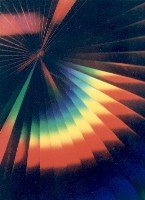
cloud and building in Austin
 cloud and building in Austin |
I could write of just about anything and it would relate to patterns. They permeate our existence to the extent that it would be difficult to find something that does NOT fit into some sort of sequence, whether it be temporal or spatial, aural or visual. We are capable of organizing splotches of color and shapes into fine art, black line symbols into letters, words, sentences and ideas, and pitches, rhythms and timbres into symphonies.
One of my favorite pastimes is observing. As humans, we are endowed with an enormous amount of cerebral matter that just demands to be occupied. Simple gathering of information through our senses would mean nothing if we didn't proceed further. Most of us don't just watch something; we think, wonder, anticipate, contrast, remember, compare, and draw conclusions. If we witness a completely unfamiliar object moving in a totally unfamiliar way, our brains begin the detective work of trying to solve the mystery by fitting this new data into our pre-existing catalog of experience. We search for patterns.
Certain very simple elements occur again and again in our environment. Circles and spirals come to mind. There are so many ways in which these motifs appear that we rarely even notice them. But try drawing a perfect circle freehand, and suddenly one's appreciation of this basic shape deepens. In true fractal manner, the round form appears from the smallest particles we have discovered to something as large as the nearest star: our Sun. Who can not be entranced by the spiral trails of atom fragments produced in a super collider?
The remarkable studies by M.C. Escher introduced me to a whole new layer of complexity when it comes to patterns. Manipulating the idea of tessellation into ever more intricate designs, he displayed the same virtuosity in his drawings as a master musician, writer or mathematician might in their respective media. Puzzles and many games are also based on our knowledge of patterns, whether it is the miniscule visual clues in a jigsaw puzzle or the mental gymnastics of chess moves.
 prism at Houston Museum of Natural Science |
Although large, impressive patterns can be dramatic, sometimes the search for the obscure, barely noticed details can be even more rewarding. The grain of a piece of lumber, the feel of a cat's fur, the cracks in a porcelain finish, or the tiny chirpings of insects, can all become something worthy of study in our never ending search for patterns.